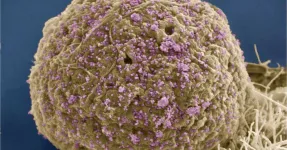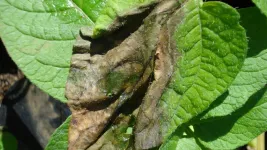(Press-News.org)
Images
By directly measuring greenhouse gas emissions from an airplane flying over the Gulf of Mexico, a University of Michigan-led team found that the nation's largest offshore fossil fuel production basin has twice the climate warming impact as official estimates.
The work could have bearing on future energy production in the gulf, as decisions about expanding oil and gas harvesting depend on calculations of the climate impact.
While a gap between reported and measured methane emissions in the basin has been noted in the past, this study is believed to be the first to quantify methane and carbon dioxide emissions and identify the main culprits. It turns out older platforms located closer to land emit far more methane than is reported in government inventories.
Simple steps could go a long way in mitigating those releases, the researchers say.
To conduct their atmospheric measurements, the researchers flew upward and downward in a cylindrical pattern around the platforms and measured amounts of both carbon dioxide and methane being released. They combined aircraft measurements with all previous field surveys to gather the largest sample size of Gulf of Mexico platform GHG emissions. Their observations quickly put a spotlight on certain oil and gas producing operations.
"What we found is that a certain type of shallow water platform had large methane emissions that elevated total greenhouse gas emissions for the entire Gulf of Mexico," said Eric Kort, U-M associate professor of climate and space sciences and engineering, principal investigator of the F3UEL project and corresponding author of the study published in the Proceedings of the National Academy of Sciences.
"So if we can direct mitigation efforts at those sources to address the problem, it could have a huge positive effect."
These sources are larger “central-hub” multiplatform complexes that collect oil and gas from small production platforms for processing. Sampling showed these emit more methane than expected, due to direct venting into the atmosphere or releases from tanks and other equipment.
Actions to address these large methane emissions, whether through capturing the gas, flaring it instead of venting, or repairing or abandoning of facilities, could have outsized climate benefits.
The finding is similar to research published in September by the same team that showed inefficient flaring operations on land were releasing five times more methane into the atmosphere than expected. Together, these studies demonstrate the need for a more comprehensive way of assessing greenhouse gas emissions, and thus the climate impact of oil and gas production for a given region. Climate impact is determined by "carbon intensity," a metric for the levels of greenhouse gasses that are emitted per unit of oil or gas produced.
When new oil and gas projects are under consideration, regulators assess whether the new builds will have the same or lower than the carbon intensity of expanded production elsewhere. This has already impacted decisions about oil and gas lease sales in the Gulf of Mexico. However, in these assessments, estimates of the carbon dioxide and methane released into the atmosphere have not historically been based on direct measurements, and many of them have not included methane emissions.
"We have presented the climate impact of both oil and gas production as an observation-based carbon intensity," said Alan Gorchov Negron, a U-M graduate student research assistant and the study's first author. "This metric reflects a snapshot of real-time climate impacts and offers an easy way to integrate the growing number of field surveys of emissions from fossil fuel production into a consistent metric.
"Moving forward, policy or investment decisions can use consistent metrics such as this to choose fossil fuels from locations that minimize their climate impacts."
The study also involved researchers from Stanford University, Scientific Aviation, Carbon Mapper and Environmental Defense Fund. The research is funded by the Alfred P. Sloan Foundation with additional support from Environmental Defense Fund, Scientific Aviation and U-M's Department of Climate and Space Sciences and Engineering and Graham Sustainability Institute.
Study (available when embargo lifts): Excess methane emissions from shallow water platforms elevate the carbon intensity of U.S. Gulf of Mexico oil and gas production (DOI: 10.1073/pnas.2215275120)
Written by Jim Lynch
END
Gulf offshore oil and gas production has double the climate impact as inventories report
High methane emissions from shallow water platforms underlie the problem
2023-04-03
ELSE PRESS RELEASES FROM THIS DATE:
Squash bees flourish in response to agricultural intensification
2023-04-03
UNIVERSITY PARK, Pa. — While pollinator populations of many species have plummeted worldwide, one bee species is blowing up the map with its rapid population expansion. The key to this insect’s success? Its passion for pumpkins, zucchinis, and other squashes, and the massive increase in cultivation of these crops across North America over the last 1,000 years.
A new study led by Penn State found that the squash bee (Eucera pruinosa) has evolved in response to intensifying agriculture — namely squashes in the genus ...
Strong ultralight material could aid energy storage, carbon capture
2023-04-03
HOUSTON – (April 3, 2023) – 2D materials get their strength from their atom-thin, sheetlike structure. However, stacking multiple layers of a 2D material will sap it of the qualities that make it so useful.
Rice University materials scientist Jun Lou and collaborators at the University of Maryland showed that fine-tuning interlayer interactions in a class of 2D polymers known as covalent organic frameworks (COFs) can determine the materials’ loss or retention of desirable ...
Calcium sensor helps us to see the stars
2023-04-03
Using cryo-electron microscopy and mass spectrometry, researchers from PSI have deciphered the structure of an ion channel found in the eye while it interacts with the protein calmodulin – a structure that has eluded scientists for three decades. They believe that this interaction could explain how our eyes can achieve such remarkable sensitivity to dim light. Their results are published in the journal PNAS.
As you look at the bright screen of your phone or computer, ion channels in your eyes close in response to the light. This is the final step of a biochemical ...
New research could spur broader use of 2D materials
2023-04-03
They’re considered some of the strongest materials on the planet, but tapping that strength has proved to be a challenge.
2D materials, thinner than the most delicate onionskin paper, have attracted intense interest because of their incredible mechanical properties. Those properties, however, dissipate when the materials are stacked in multiple layers, thus limiting their usefulness.
“Think of a graphite pencil,” says Teng Li, Keystone Professor at the University of Maryland’s (UMD) Department of Mechanical Engineering. “Its core is made of graphite, and graphite ...
April issues of American Psychiatric Association journals cover genetic underpinnings of common disorders, a digital intervention for depression and anxiety in youth, and more
2023-04-03
WASHINGTON, D.C., April 3, 2023 — The latest issues of three of the American Psychiatric Association’s journals, The American Journal of Psychiatry, Psychiatric Services, and The American Journal of Psychotherapy, are now available online.
The April issue of The American Journal of Psychiatry features genetic, neuroimaging, and behavioral neuroscience studies that focus on the underpinnings of mood disorders, psychotic disorders, autism, and stress-related disorders. Highlights from the issue:
Lower Availability of Mitochondrial Complex I in Anterior Cingulate Cortex in ...
Royal reception on Commonwealth Day 2023 for Sri Lankan PhD researcher
2023-04-03
A PhD researcher from the University of Huddersfield’s Global Disaster Resilience Centre (GDRC) was invited by His Majesty The King and The Queen Consort to attend a special reception at Buckingham Palace and more, in celebration of Commonwealth Day 2023.
Malith Senevirathne is a PhD student at the GDRC, within the University’s School of Applied Sciences and a Research Assistant for the CORE project (sCience and human factOr for Resilient sociEty), funded by the European Commission. As ...
Can investigators use household dust as a forensic tool?
2023-04-03
A North Carolina State University-led study found it is possible to retrieve forensically relevant information from human DNA in household dust. After sampling indoor dust from 13 households, the researchers were able to detect DNA from household residents over 90% of the time, and DNA from non-occupants 50% of the time. The work could be a way to help investigators find leads in difficult cases.
Specifically, the researchers were able to obtain single nucleotide polymorphisms, or SNPs, from the dust samples. SNPs are sites within the genome that vary between individuals – corresponding ...
Center for AIDS Research receives $15 million renewal grant from NIH
2023-04-03
The National Institute of Allergy and Infectious Diseases (NIAID), part of the National Institutes of Health, has awarded a five-year, $15.45 million grant to the San Diego Center for AIDS Research (SD CFAR) at UC San Diego, renewing support that extends back to an original establishing grant in 1994 at the height of the AIDS epidemic.
"The grant renewal represents NIAID's continued and enduring investment in our mission to be a critical regional resource in HIV research and education, to advance the discovery and development of ...
Moderate exercise safe for people with muscle pain from statins
2023-04-03
Statin therapy does not exacerbate muscle injury, pain or fatigue in people engaging in moderate-intensity exercise, such as walking, according to a study published today in the Journal of the American College of Cardiology. The findings are reassuring for people who experience muscle pain or fatigue from statins but need to engage in physical activity to keep their cholesterol levels low and their hearts healthy.
Statins have long been the gold standard for lowering LDL or “bad” cholesterol ...
NC State researchers assemble pathogen ‘tree of life’
2023-04-03
A new online tool – the first of its kind for plant pathogens – will help researchers across the globe identify, detect and monitor species of Phytophthora, which have been responsible for plant diseases ranging from the devastating 1840s Irish potato famine to sudden oak death that still plagues West Coast oak population.
The new pathogen “tree of life” provides a plethora of information about each of the more than 192 formally described species – including their evolutionary history and relationships within groups – as well as more than 30 other informally described taxa. It also includes ...
LAST 30 PRESS RELEASES:
University of Oklahoma researcher awarded funding to pursue AI-powered material design
Exploring how the visual system recovers following injury
Support for parents with infants at pediatric check-ups leads to better reading and math skills in elementary school
Kids’ behavioral health is a growing share of family health costs
Day & night: Cancer disrupts the brain’s natural rhythm
COVID-19 vaccination significantly reduces risk to pregnant women and baby
The role of vaccination in maternal and perinatal outcomes associated with COVID-19 in pregnancy
Mayo Clinic smartwatch system helps parents shorten and defuse children's severe tantrums early
Behavioral health spending spikes to 40% of all children’s health expenditures, nearly doubling in a decade
Digital cognitive behavioral treatment for generalized anxiety disorder
Expenditures for pediatric behavioral health care over time and estimated family financial burden
Air conditioning in nursing homes and mortality during extreme heat
The Alps to lose a record number of glaciers in the next decade
What makes a good proton conductor?
New science reporting guide published for journalists in Bulgaria
New international study reveals major survival gaps among children with cancer
New science reporting guide published for journalists in Turkey
Scientists develop a smarter mRNA therapy that knows which cells to target
Neuroanatomy-informed brain–machine hybrid intelligence for robust acoustic target detection
Eight SwRI hydrogen projects funded by ENERGYWERX
The Lundquist Institute and its start-up company Vitalex Biosciences Announces Strategic Advancement of Second-Generation fungal Vaccine VXV-01 through Phase 1 Trials under $40 Million Competitive Con
Fine particles in pollution are associated with early signs of autoimmune disease
Review article | Towards a Global Ground-Based Earth Observatory (GGBEO): Leveraging existing systems and networks
Penn and UMich create world’s smallest programmable, autonomous robots
Cleveland researchers launch first major study to address ‘hidden performance killer’ in athletes
To connect across politics, try saying what you oppose
Modulating key interaction prevents virus from entering cells
Project explores barriers to NHS career progression facing international medical graduates
Jeonbuk National University researchers explore the impact of different seasonings on the flavor perception of Doenjang soup
Two Keck Medicine of USC Hospitals named Leapfrog Top Teaching Hospitals
[Press-News.org] Gulf offshore oil and gas production has double the climate impact as inventories reportHigh methane emissions from shallow water platforms underlie the problem






